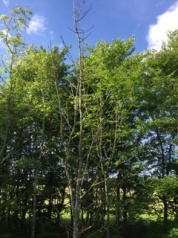This is a shortened version of an article by Professor Allan Downie and Dr Anne Edwards originally published in Norfolk Gardens Trust News, Autumn 2016. Reproduced here with permission.
The ash is one of our more common large trees and is a distinctive feature of our landscape but this is under threat. Experts from the John Innes Centre, Norwich, tell us about advances in understanding ash dieback.

Ash dieback disease swept east-west across Europe, appearing in 2012 in Ashwellthorpe Lower Wood, a Norfolk Wildlife Trust nature reserve. The disease has since spread widely including to the woods of Magog Down and looks set to cause the loss of many ash trees in the coming years. Over the last three years, plant scientists at the John Innes Centre in Norwich have collaborated with experts from across the country and mainland Europe to study the disease.
What causes ash dieback?
The disease-causing organism is Chalara fraxinea. The disease cycle starts when spores of this fungus land on ash leaves from June to September. After a few weeks brown lesions appear on leaves, which eventually die prematurely on the tree. In autumn, the leaves fall and fungal growth continues. By late spring the only recognizable part of the leaf is the rot-ting leaf stem and by about June-July small white mushroom-like structures – about the size of match-heads – appear on the leaf stems. These fruiting bodies fire spores into the air (up to 8 million spores per fruiting body), where they are caught by the wind. These airborne spores spread ash dieback disease by landing on young ash leaves, restarting the cycle.
Where does ash dieback disease come from?
It arrived in the UK by two routes. One was on infected ash trees that had been imported after UK ash seeds had been propagated in nurseries in Europe where the disease was al-ready established. However, the main source of infection in East Anglia was probably due to airborne spread of spores that had been fired into the air in mainland Europe and blown to the UK.
What can we do about ash dieback disease?
If you have an affected ash tree in your garden, clearing up and burning the fallen leaves in autumn would reduce the rate of reinfection. However, with trees in woodland and in hedgerows this is not practical nor is the use of fungicides.
The only long-term answer will be to select UK trees that can tolerate the disease. Some European ash trees seem to tolerate the pathogen by slowing its growth in the tree. In Denmark, they know that about 2% to 5% of ash have such characteristics and scientists at the University of York, the University of Copenhagen, the John Innes Centre and The Genome Analysis Centre in Norwich have identified genetic markers associated with this disease tolerance. The hope is that these genetic markers may allow selection of UK seedlings that are likely to tolerate the disease and so survive long term.
How bad will it get for our ash trees?
In Denmark, more than 90% of ash trees show significant signs of the disease. Many of these trees will not die due to ash dieback, but will be weakened, making them more susceptible to other diseases like honey fungus. We just do not know how bad it will be in the UK. UK and Danish ash trees have some genetic differences, so we can hope that some of our trees show long-term tolerance. In time, we may be able to identify healthy trees surrounded by sick ash trees – we can already do this in Ashwellthorpe Lower Wood. We can collect the seeds from the best trees and start to spread them on the principle (as yet untested) that the progeny from these tolerant ash trees will survive in the longer term.
Bryan Davies
